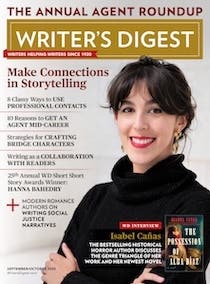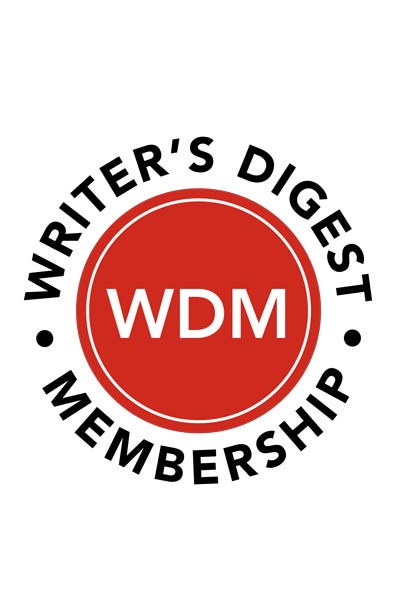You Can Write a Novel, 2nd Edition
Get your novel from idea to bookstore with James V. Smith, Jr. in You Can Write a Novel, 2nd Edition.
You Can Write a Novel, 2nd Edition
By James V. Smith, Jr.
Writer's Digest Books, 2010
ISBN-13: 978-1-58297-961-8
ISBN-10: 1-58297-961-8
$14.99 paperback, 176 pages
Find out how to organize your story in incidents rather than scenes and craft the three most critical incidents in your novel.
Novelist James V. Smith, Jr. shares his insights into the writing life in this exclusive Q&A.
About the Book
Do you have an idea for a great novel? Have you always dreamed of writing a bestseller? Are you at a loss for where to start? Look no further. You Can Write a Novel, 2nd Edition, gives you concrete, proven techniques to get from idea, to manuscript, to bookstore.
Veteran author James V. Smith, Jr., breaks down the novel writing process into ten logical steps. You’ll start building the foundation for your book right away by taking your story’s three most important incidents from brainstorm to final draft perfection.
Smith’s approach will guide you through a practical sequence designed to keep you focused, organized, and moving forward. You Can Write a Novel skillfully and simply addresses the essentials, such as plot, character, setting, dialogue, and action. You’ll learn how to generate a salable idea, develop your idea into a framework, and build your framework into a finished manuscript.
This edition includes new brainstorming tools, fresh plot and character organization strategies, and innovative tools to evaluate your story’s readability and pacing—plus, you’ll find the one-word key to every best-selling novel. And, as always, Smith’s upbeat, accessible style will cheer you on from start to finish. Start writing your novel today!
About the Author
James V. Smith, Jr., is now the editor, chief photographer and writer for Montana's largest circulation publication, Rural Montana magazine, an association magazine in the energy industry that routinely wins top national writing and photo awards within the energy industry, including the best of the state magazines of this type twice in the four years he has been there.
Altogether, Jim has written and published five novels in the military action genre, including two Delta Force novels depicting the aftermath of 9/11 under the pen name, John Harriman. He also has written and self-published The Creative Corporate Writer, because he needed it for corporate workshops for SAFECO, Microsoft, Lockheed Martin and the King County (Seattle) Public Library system. Not to mention the LA, Philadelphia and Chicago workshops he did for WD on YCWAN.
Table of Contents
Step One: Identify the One-Word Key to Every Best Seller
* Discover the one-word key to your coming writing success.
* Adopt a single, unified, game-changing YCWAN concept that will reinvent your writing with its sixteen elements for grabbing readers, dragging them into your novel, and compelling them to talk about it.
* Learn to recognize sixteen sins that diminish the sixteen elements of the YCWAN system.
Step Two: Sketch the First Draft of Your Novel in Only Two Incidents
* Learn why you should write Incidents instead of scenes.
* And, incidentally, learn what an Incident is and what the two most important Incidents are in you novel.
* Structure your story using the YCWAN A to Z method.
* Write at least a sketch of your two most important Incidents.
Step Three: Test Your Novel for Salability
* Examine the sixteen elements of participation at work.
* Test your novel against the essential elements of a salable novel.
* Amp up the essential elements of your novel.
* Write a brief Nugget Statement that will focus your efforts in writing and selling your novel
Step Four: Invent Key Details to Enrich Your Rough Draft and Smooth the Way for the Rest of Your Novel
* Refine a working title.
* Add a digital cast of characters.
* Select names for your characters.
* Adopt a point of view.
Step Five: Get Down to Some Serious Writing
* Use the Incident checklist as the basis for writing your plot or story structure.
* Rewrite your first draft Incidents using the YCWAN system, especially the ACIIDSS Test.
* Evaluate the Opener of a best seller.
* Avoid mistakes of amateurs.
Step Six: Evaluate Your Opener Incident for Reading Ease and Reader Participation
* Edit your Opener Incident using numeric goals as a guide.
* Inject precision into your novel by choosing the right words.
* Take the first steps to reinvent your writing style.
* Scan your Opener for greater reading ease and participation.
* Write more compact Incidents, starting with your very next one.
Step Seven: Create the Rest of Your Main Story Line as a Series of Headlines
* Create the rest of your central story line—structuring the easy way.
* Write your Point of No Return Incident.
* Develop the Closer Incident further.
* Apply the simplest of structures to Incidents, Tragedy Versus Triumph.
Step Eight: Revise Your Novel to Best-Seller Standards
* Clean up the mechanics of your novel.
* Apply some advanced revision techniques.
* Create tie backs and transitions.
* Add texture to your story.
* Set your words to music
Step 9: Market Your Novel by Creating an Irresistible Package That Engages Editors and Agents
* Get real about what can happen when you submit your novel.
* Identify the selling points of your story.
* Analyze the marketplace.
* Prepare your pitch.
* Prepare your package.
Step 10: Polish Your Novel to Best-Seller Standards While Your Sales Package Is Out There Pitching for You
* Evaluate the pace of every Incident in your novel.
*Revise to adjust the pace within each Incident that needs it.
* Evaluate the pace of your novel as a whole and graph its intensity level from beginning to end.
* Revise as necessary to reset intensity and pace.



